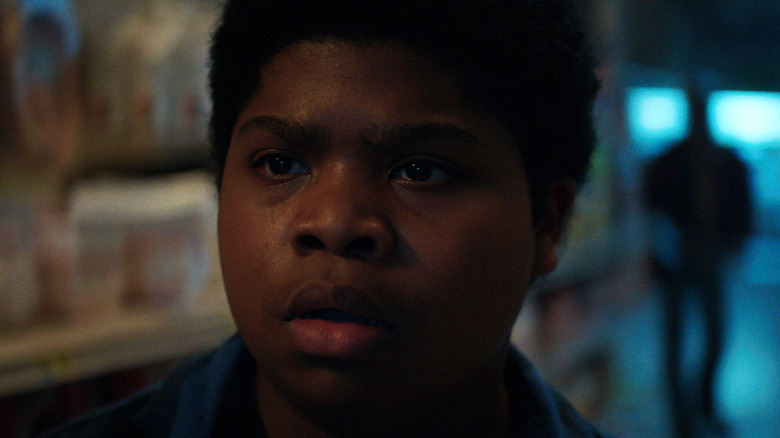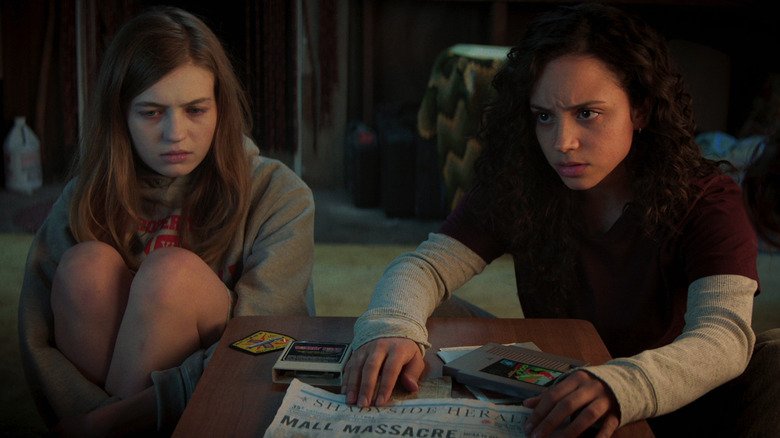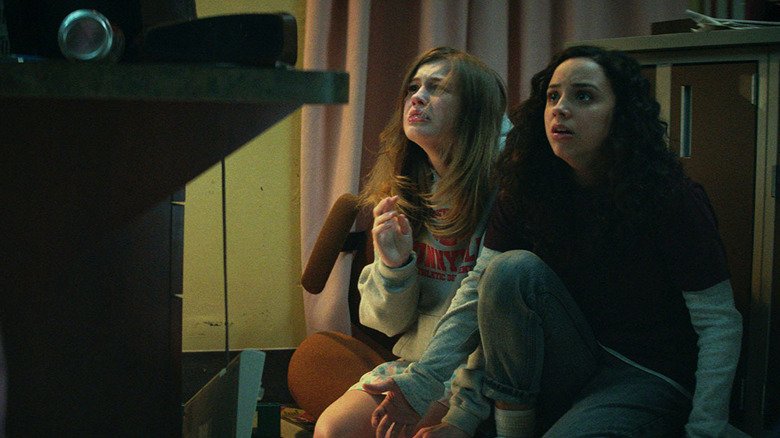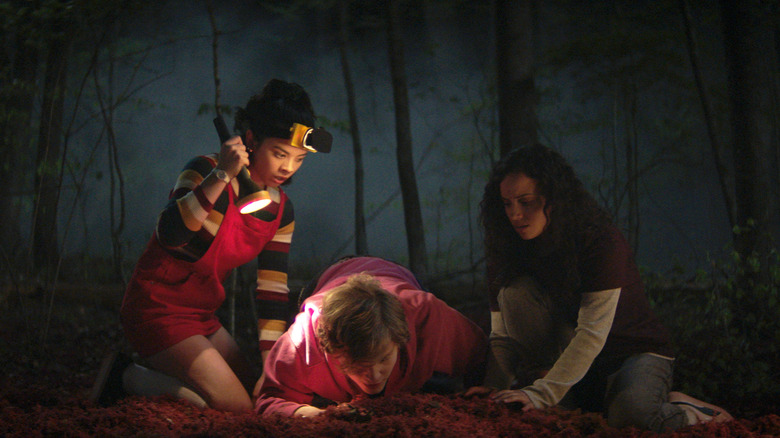The Ending Of Fear Street Part 1: 1994 Explained
"Fear Street Part 1: 1994" is the first of three films set in the universe built by renowned children's horror author R.L. Stine. "Fear Street" is a young adult horror series that focuses on teen characters living in the seemingly cursed town of Shadyside. The characters are haunted by supernatural situations that are largely the result of a curse placed upon the "Fier" family centuries earlier. The story goes that family patriarch Simon Fier had mother and daughter Susannah and Martha Goode burned for witchcraft back in the Puritan era. The family eventually changed their name from "Fier" to "Fear," thus setting up the name of the titular street. The Fear family is supposedly long gone, but the curse on the town still remains.
With the resurgence of Stine's "Fear Street," the franchise recently made the leap to Netflix. "Fear Street Part 1: 1994" takes the story back to the '90s when most of the novels were written, giving the story a "Scream" vibe in the process — we get masked killers, disaffected teens, and a soundtrack straight out of one of the biggest years in alternative rock history.
This first of three films already inverts some of the core elements of "Fear Street." Notably, the family's roles seem to be reversed with someone named Sarah Fier (Elizabeth Scopel) being the evil witch cursing the town of Shadyside while chief of police Nick Goode (Ashley Zukerman) protects it (at least as far as we know).
What does all of that mean for the end of the first chapter of the new "Fear Street" saga and how does it feed into the next chapter, "Fear Street Part 2: 1978"? Let's take a look at the set-up and final moments and inspect the textual, the subtextual, and even the metatextual.
Nothing is scarier than inequality on Fear Street
"Fear Street Part 1: 1994" is a story about inequity. The town of Shadyside is beset by a curse placed on the town by Sarah Fier who was brutally murdered for being a witch in 1666. Historically speaking, witch burnings in the real world were not terribly equitable — they were mostly puritanical leadership using oppressive power to end the lives of people they deemed outside of an acceptable norm.
Existing in direct opposition to Shadyside is neighboring town Sunnyvale where there is no crime, no murder, and no curse. Everyone who lives in Sunnyvale is financially well off and successful, while residents of Shadyside seem to be low-income and struggling. If you've ever lived in United States suburbia, you've likely lived in a town that fits into one of these two archetypes — the rich-kid town and the proverbial "wrong side of the tracks" town. Again, "Fear Street" is a story about inequity.
On a character level, we see inequity as well. While the film has an ensemble cast, at its heart, the first "Fear Street" movie is mostly about the romantic relationship between Deena (Kiana Madeira) and Samantha Fraser (Olivia Scott). Sam moves from Shadyside to Sunnyvale, and, in the process, breaks up with Deena in order to escape not only the stigma of the town but also the stigma of being an out, queer woman. However, much like a witch's curse on a town, there are consequences to living a closeted identity, both to the individual and to the people around them.
Inequity also informs Fear Street Part 1: 1994's ending
After an altercation between Shadyside and Sunnyvale's students, Sam accidentally disturbs Sarah Fier's burial site, causing the witch's spirit to attempt to kill both Sam and anyone who has been physically tainted by her blood. Fier possesses people and turns them into killers — an activity she's been doing for centuries. Sam is then attacked by the spirits of the people Fier has possessed.
The story ends with Deena and Sam's friends Kate (Julia Rechwald) and Simon (Fred Hechinger) being brutally murdered by Fier's possessed killers before Deena and Sam can defeat the curse by temporarily killing Sam. Sheriff Goode publicly places the blame for the events on Kate and Simon because they are already dead and they were drug dealers, making them easy targets for blame.
However, Deena gets a call from a previous survivor of Fier's curse, C. Berman (Gillian Jacobs), who warns the curse isn't over. This happens just in time for Sam to become possessed and try to stab Deena to death. And, yes, these final moments are also all about inequity.
Understanding Fear Street through its history
Why do Sam, Deena, and Deena's brother Josh (Benjamin Flores Jr.) all blame their friends Kate and Simon rather than tell the truth to Sheriff Goode? The answer is simple: they know that he won't believe them. Why would three people who feel oppressed in one way or another trust the police, a symbol of that oppression, to help them? Even a good (or, in this case, Goode) cop isn't trustworthy.
However, while lying to the police means temporary survival, the cycle of oppression, much like Sarah Fier's curse, continues. That's a big part of why Fier's curse possesses Sam — it's a manifestation that the systemic issue remains. Throughout the story of "Fear Street Part 1: 1994" all the characters save one are mostly fixated on surviving the moment. Only Josh has a researched awareness of the history of the curse on Shadyside — and it's no accident that his knowledge is what sees some of them survive.
At the end of the first "Fear Street" movie, we get a trailer showing that the call from C. Berman leads our protagonists to visit with Berman and learn her story of survival. In essence, ending on Sam's possession and a need to speak with Berman is the film's way of telling us that the only way to defeat systemic inequity is through understanding its history. And we know that eventually learning about Berman's story will lead the audience to the third and final film, "Fear Street Part 3: 1666" — a movie that will likely explain the true story of Sarah Fier, the Fiers and the Goodes in general, and where the inequity between Shadyside and Sunnyvale originally began.
"Fear Street Part 1: 1994" is streaming on Netflix now.



